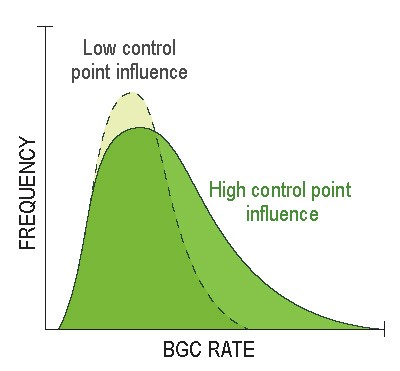
Quantifying influences of hot spots/moments over total system function as control point influence (CPI) provides opportunities to reveal governing processes through cross- site and multi-scale comparisons.
The Science
The Critical Zone – the environment from fresh bedrock to canopy – involves very different environmental properties and processes. Therefore, studying this environment at multiple time scales is needed to better predict and understand ecosystem fluxes, exchange rates and biogeochemical functioning. Hot spots and hot moments (HSHMs) are regions or times in the environment that, when compared to surrounding areas or intervening times, experience high reaction rates and significantly influence environmental processes or natural resource quality. Researchers reviewed models, questions and recent findings involving HSHMs to better understand how they impact nutrient dynamics, greenhouse gas emissions, and water and energy exchanges in the critical zone.
The Impact
HSHMs can largely impact environmental processes and natural resource quality. Studying and quantifying HSHMs can help address natural resource management issues such as groundwater contamination, heavy metal transport, and toxic algal blooms by identifying dominant times and regions that control carbon, nutrient, water and energy exchanges. To better understand the Critical Zone and HSHMs that largely influence these ecosystem processes, researchers have provided a description of the HSHMs concept, example applications, and a path forward using numerical modeling. Incorporating HSHMs into critical zone science can help better predict ecosystem function and manage natural resource quality as earth’s climate changes.
Summary
The Critical Zone encapsulates interacting ecosystem levels from the atmosphere to soil, groundwater and bedrock. Differences in these environments occur at multiple scales, posing challenges to understanding the zone holistically. However, predicting how this zone functions is critical to protecting natural resources and monitoring environmental processes such as water and element cycling.
HSHMs can significantly impact environmental quality and functioning – for example, spring melt and storm events can result in hot moments that largely contribute to mercury loading into nearby water bodies, having direct consequences for fish spawning and ecosystem health. Because of their substantial environmental influence, quantifying and modeling these moments and areas in the Critical Zone can help scientists better predict and manage ecosystem function and natural resource quality. Scientists’ review of HSHMs shows that incorporating them into modeling can help quantify ecosystem processes such as nutrient dynamics, greenhouse gas emissions, and water and energy exchange in the critical zone.
Citation
Arora, B., Briggs, M.A., Zarnetske, J.P., Stegen, J., Gomez-Velez, J.D., Dwivedi, D. and Steefel, C., 2022. Hot Spots and Hot Moments in the Critical Zone: Identification of and Incorporation into Reactive Transport Models. Biogeochemistry of the Critical Zone (2022), DOI: 10.1007/978-3-030-95921-0_2.
